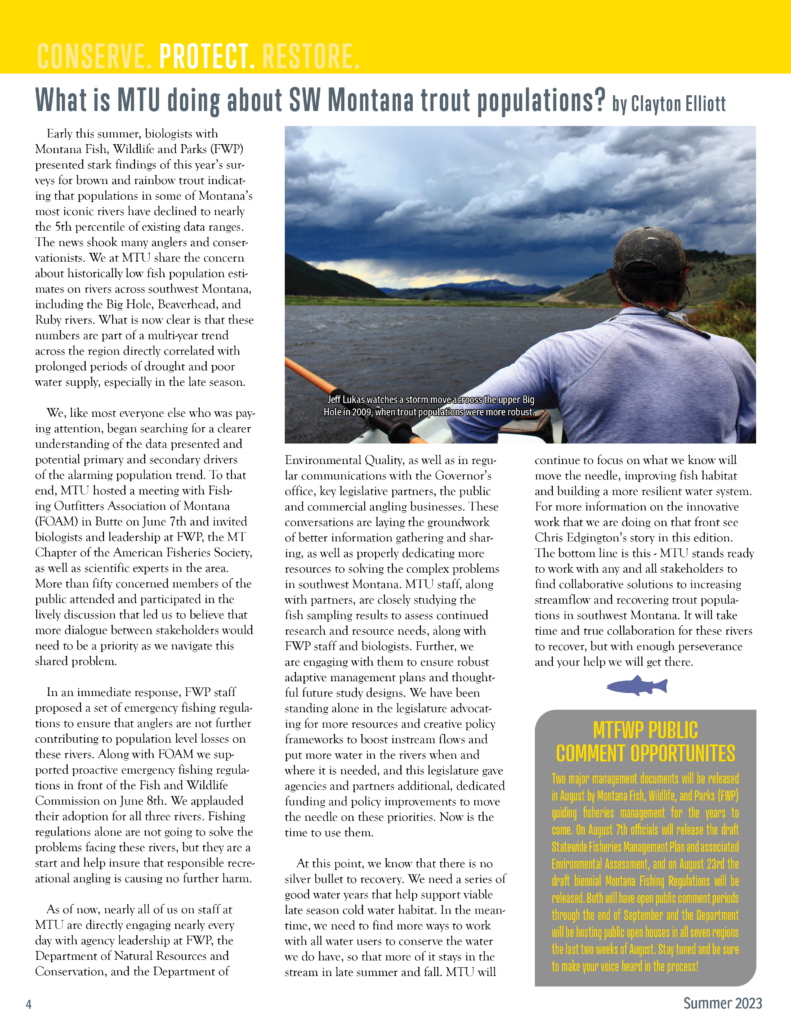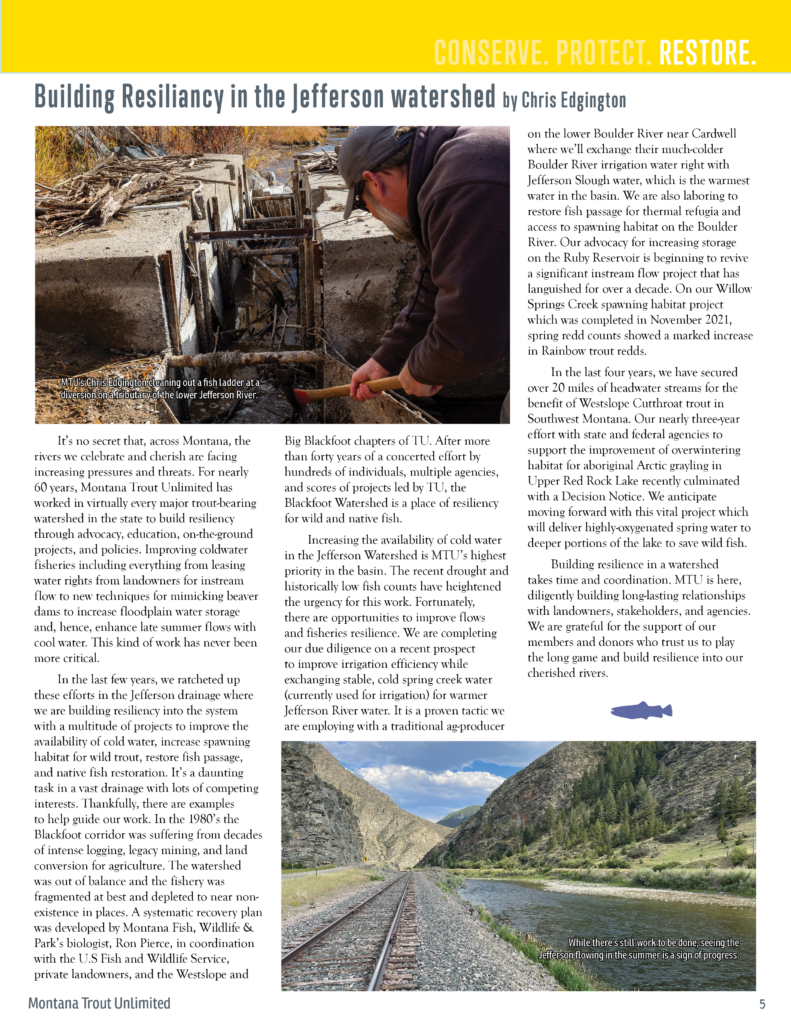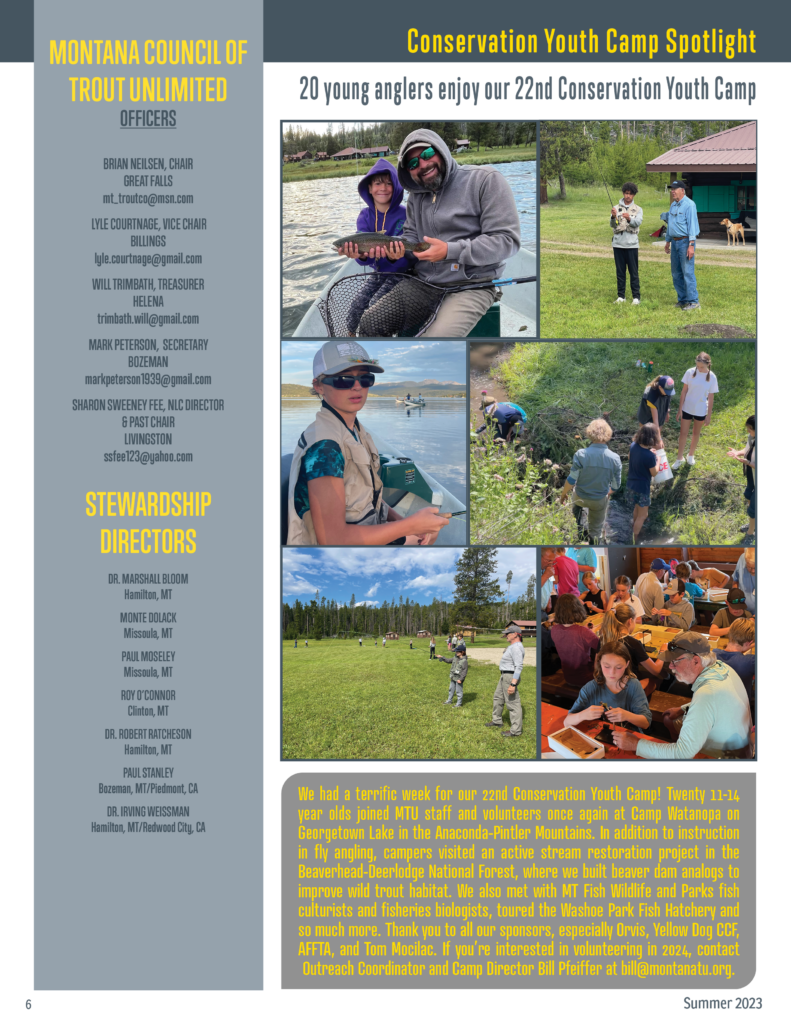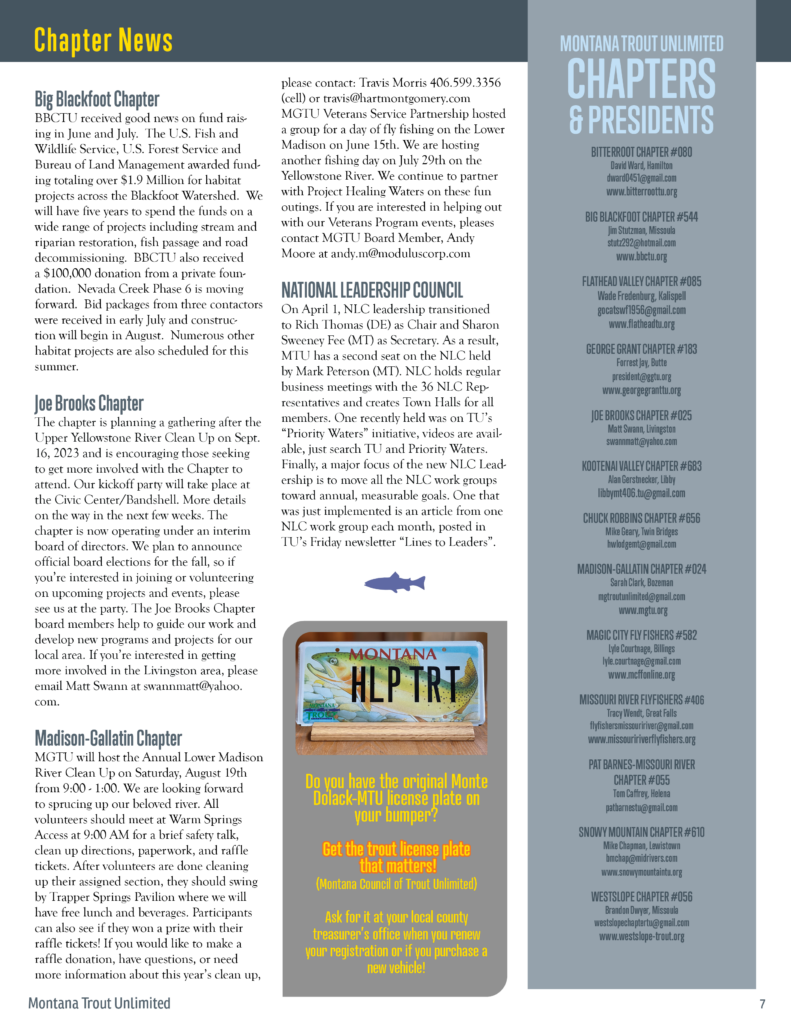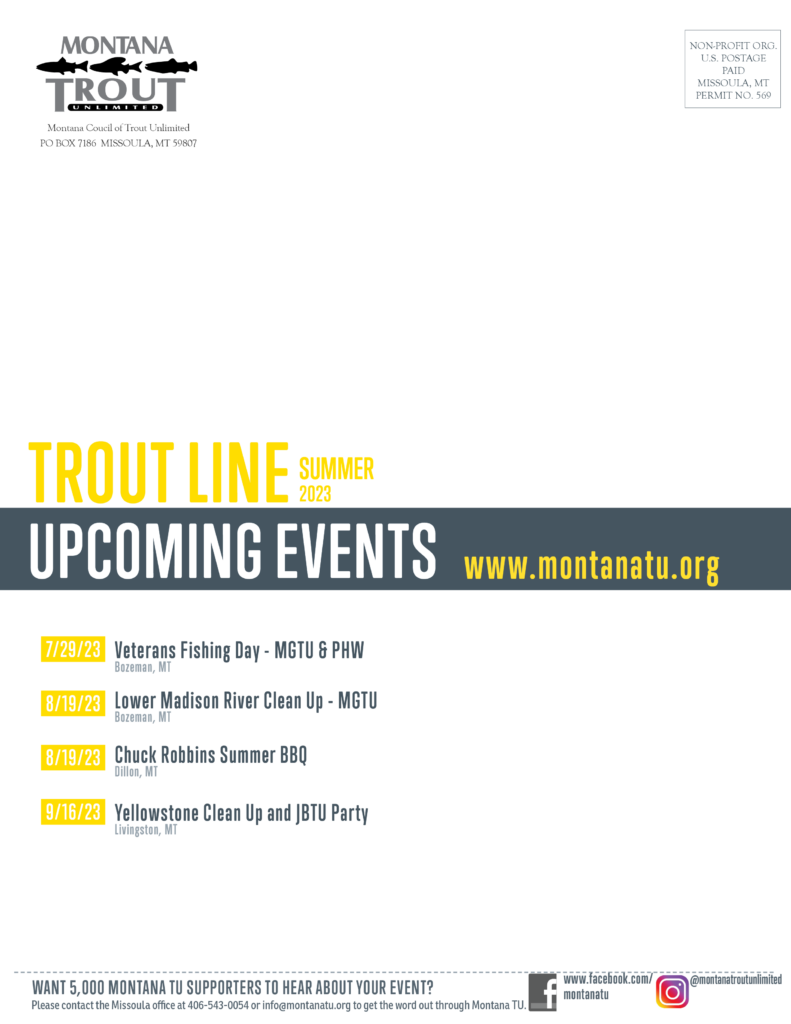Check out the latest issue of MTU’s Trout Line newsletter! Read it online here or download a PDF for your favorite reading device. To join our mailing list, email [email protected].
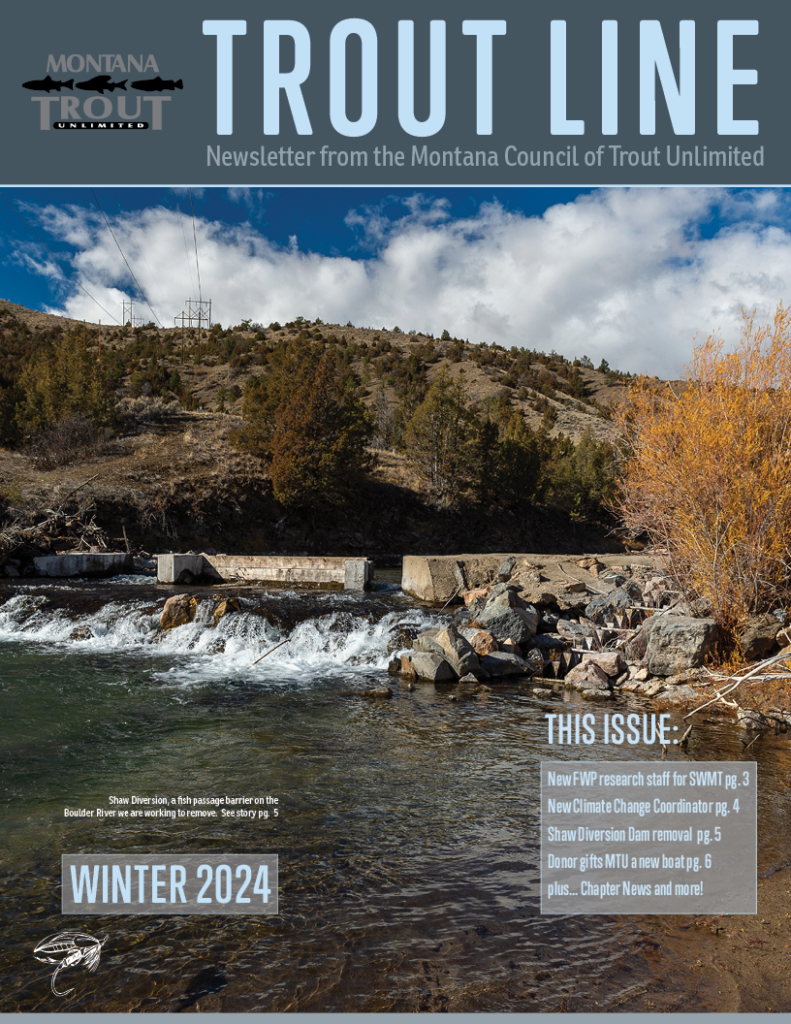
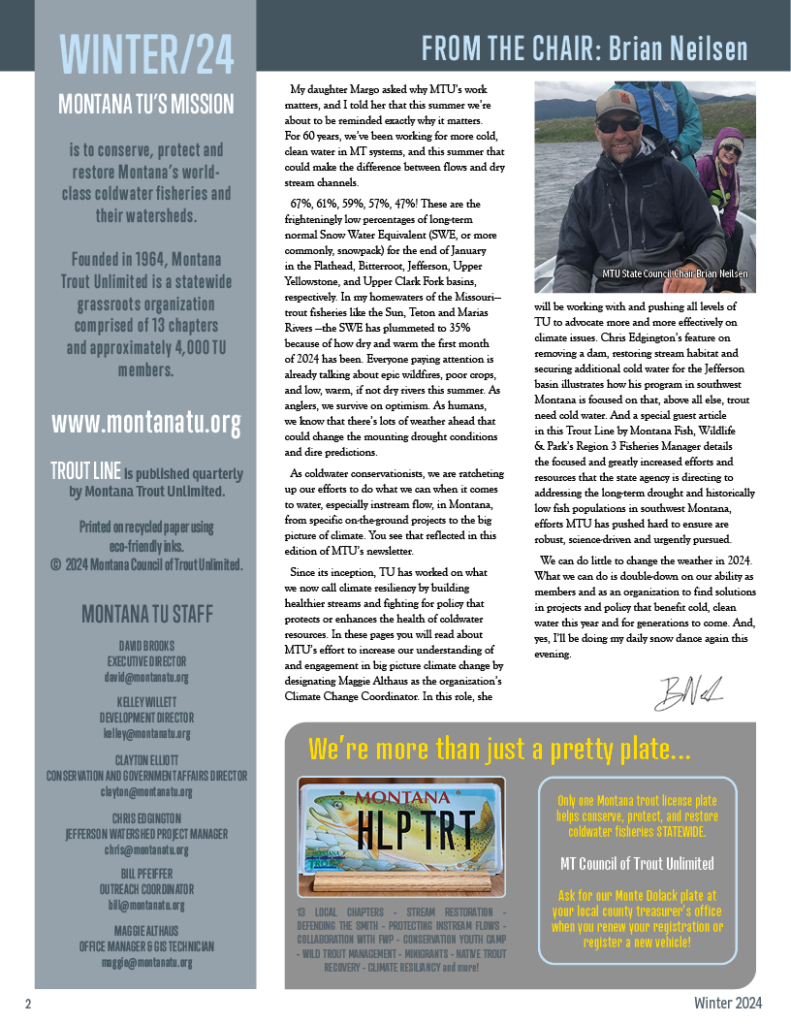
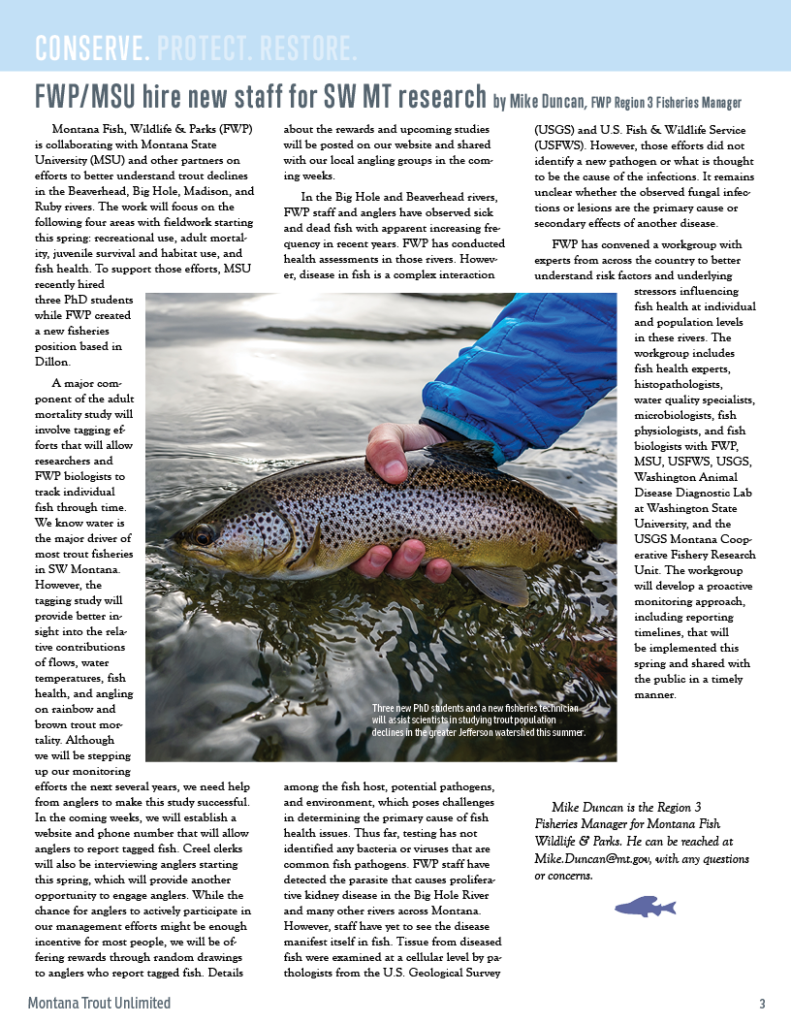
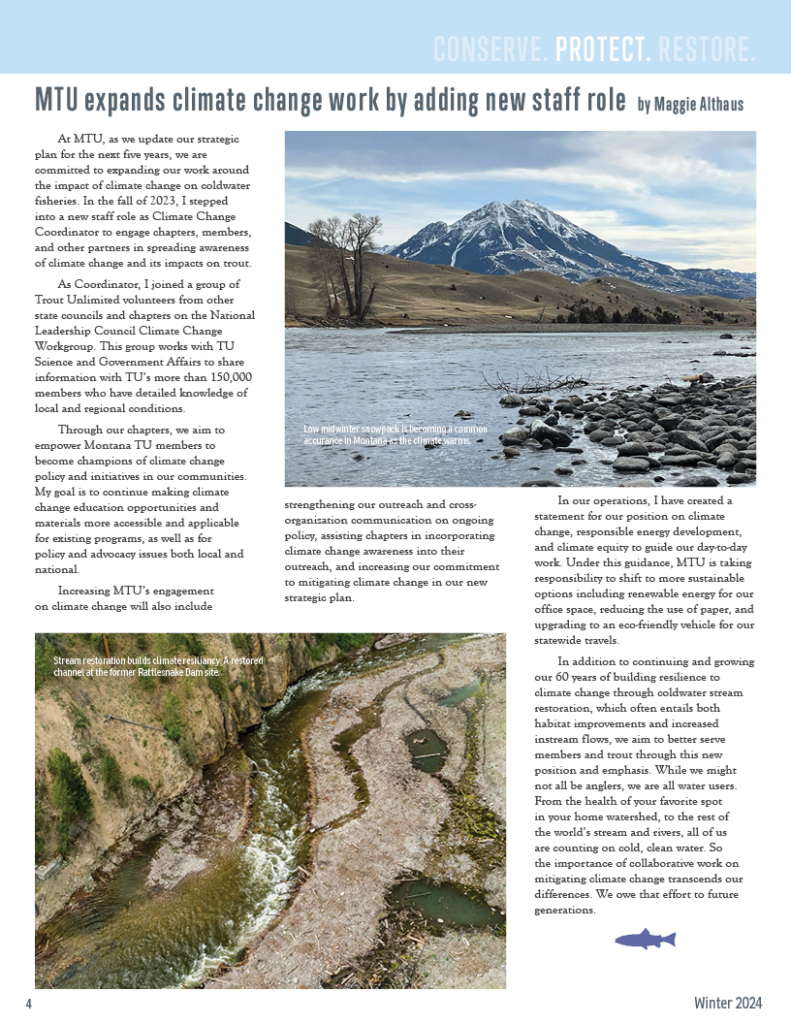
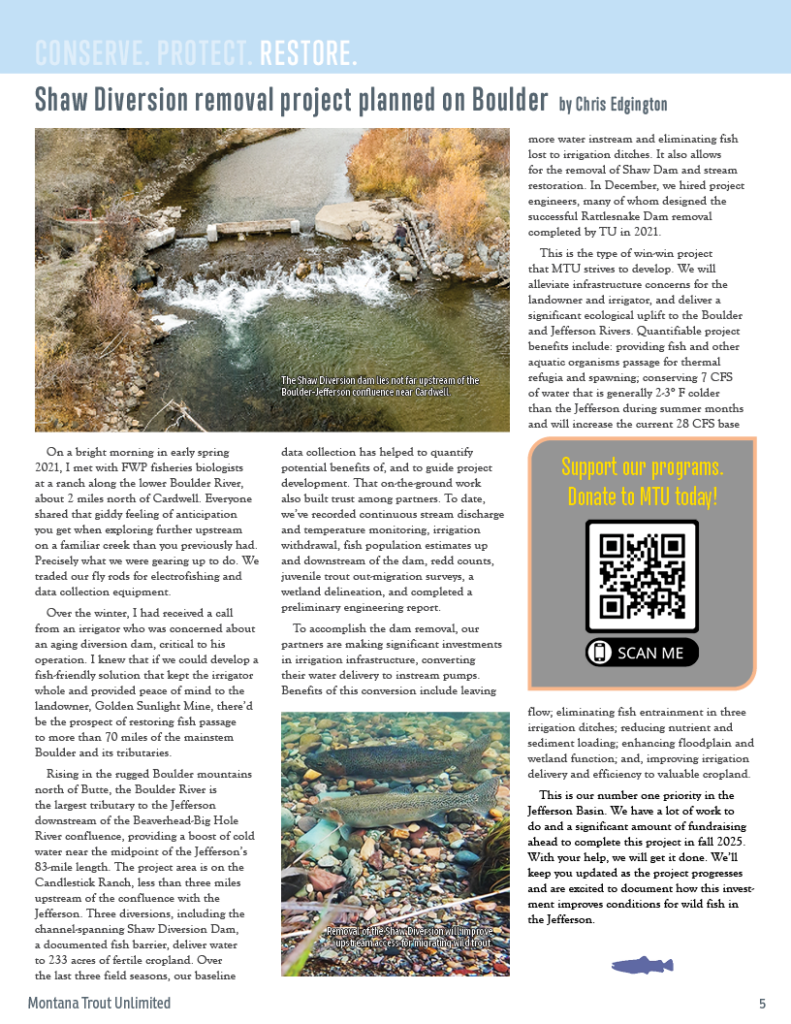
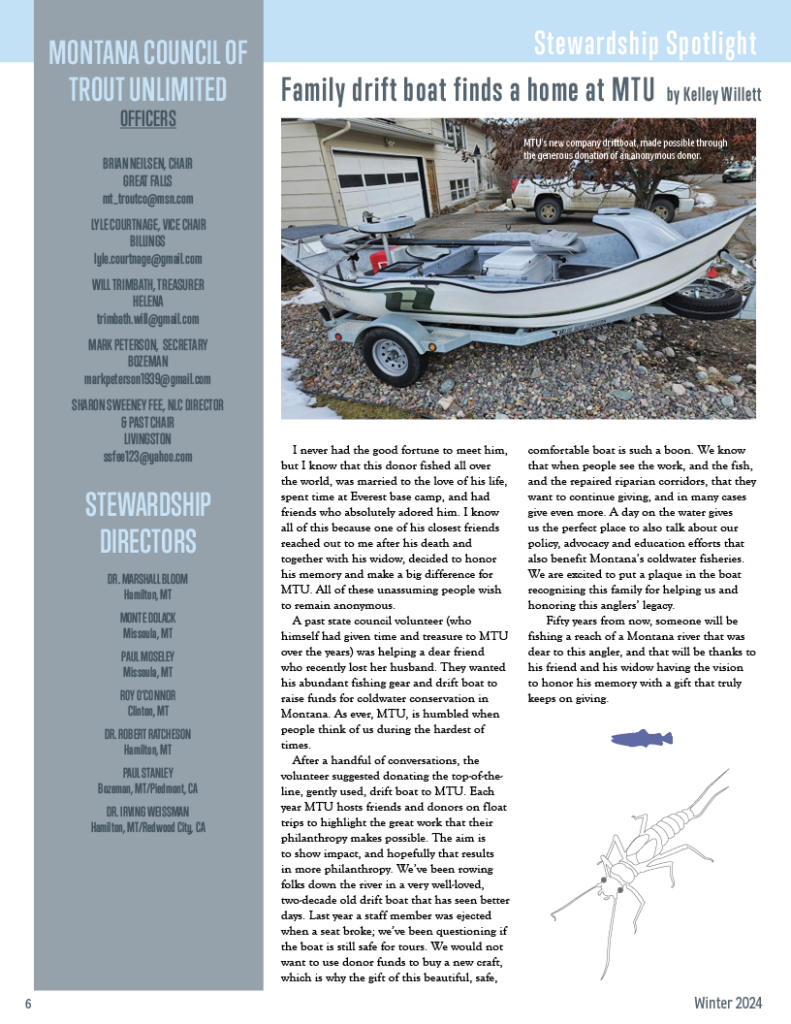
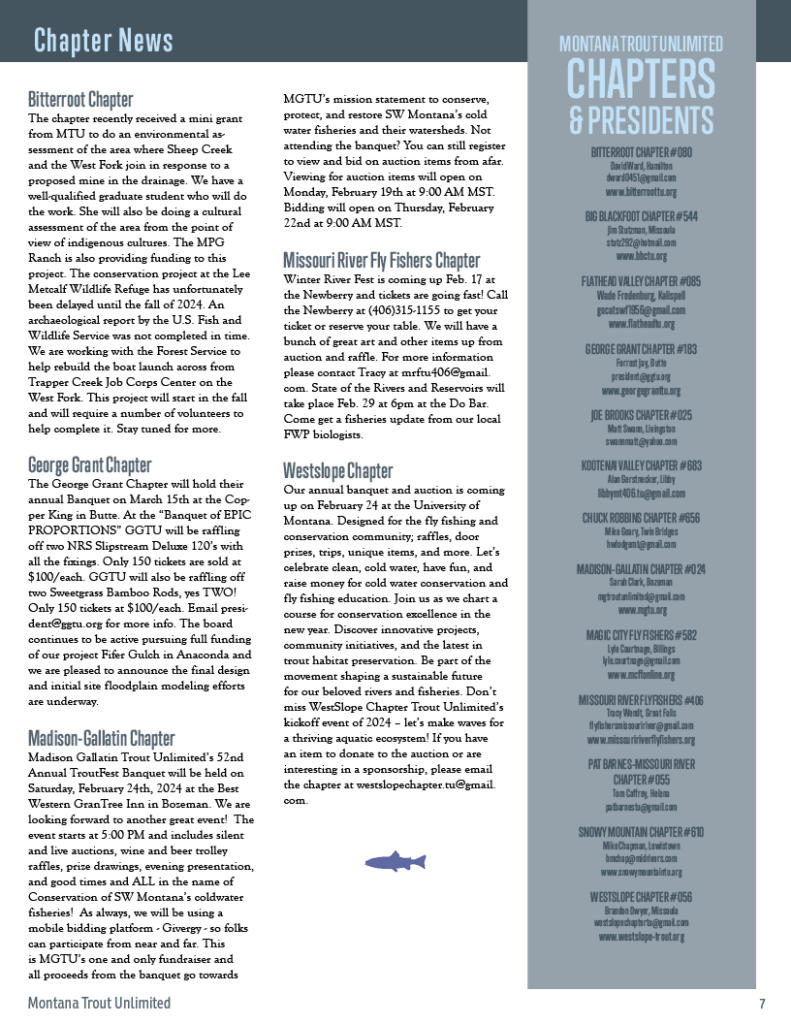
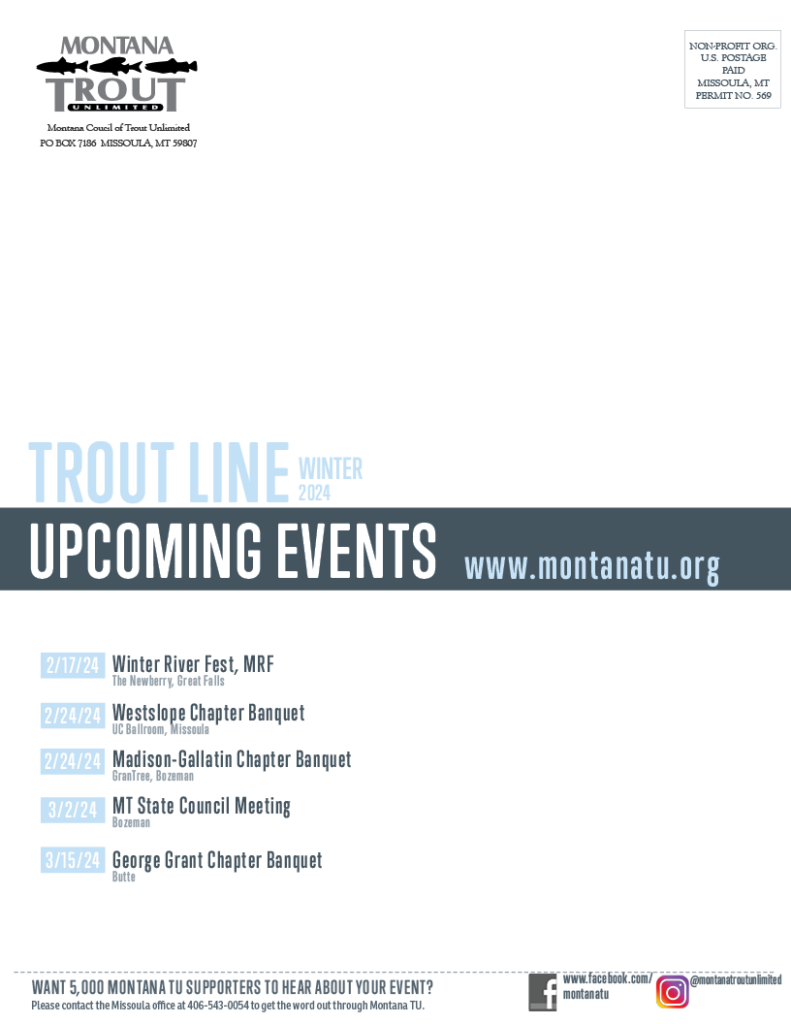

Check out the latest issue of MTU’s Trout Line newsletter! Read it online here or download a PDF for your favorite reading device. To join our mailing list, email [email protected].








By Kelley Willett
I never had the good fortune to meet him, but I know that Farnum Alston fished all over the world. His friendships and achievements also span the globe. Farnum’s resume lists a plethora of accomplishments that are a testament to his lifelong commitment to public service and environmental protection.
I know all of this because one of his friends (a past MTU volunteer who has also given time and treasure to MTU) reached out to MTU after his death and together with Farnum’s widow, decided to honor his memory and make a big difference for Montana Trout Unlimited. They wanted his abundant fishing gear and drift boat to raise funds for cold-water conservation in Montana. As ever, MTU, is humbled when people think of us during the hardest of times.
Each year MTU hosts friends and donors on float trips to highlight the great work that their philanthropy makes possible. The aim is to show impact, and hopefully that results in more philanthropy. We’ve been rowing folks down the river in a very well-loved, two-decade old drift boat that has seen better days. Last year a staff member was ejected when a seat broke; we’ve been questioning if the boat is still safe for tours. We would not want to use donor funds to buy a new craft, which is why the gift of this beautiful, safe, comfortable boat is such a boon. We know that when people see the work, and the fish, and the repaired riparian corridors, that they want to continue giving, and in many cases give even more. A day on the water gives us the perfect place to also take about our policy, advocacy and education efforts that also benefit MT’s coldwater fisheries. We are excited to put a plaque in the boat recognizing this family for helping us and honoring this anglers’ legacy.
Fifty years from now, someone will be fishing a reach of a Montana river that was dear to this angler, and that will be thanks to his friend and his widow having the vision to honor his memory with a gift that truly keeps on giving.
To make a gift in Farnum’s memory, please consider Montana Trout Unlimited, which conserves, protects and restores the very Montana cold-water fisheries that he loved.
Checks can be mailed to: MTU, PO Box 7186, Missoula, MT 59807, or give online at www.montanatu.org.
ABOUT MONTANA TROUT UNLIMITED
Montana Trout Unlimited (MTU) represents more than 4,200 members and supporters organized into 13 chapters in Montana. We are a small, dedicated, creative staff tasked with overseeing our mission to conserve, protect, and restore Montana’s coldwater fisheries and their watersheds. MTU fulfills this mission through staff and volunteer-led outreach and education, fundraising, policy development, and science-driven stream restoration.
For more than two decades, MTU has regularly partnered with our national Trout Unlimited project managers and other stakeholders on streamflow and habitat restoration work across the state. Our work focuses on restoring instream flow, fish passage, and improving habitat for the benefit of native and wild trout populations in the Clark Fork, Missouri, Gallatin, Madison, Jefferson, Yellowstone, and many major tributary rivers and streams. In all of these geographies, we work collaboratively with federal and state agencies, as well as other nonprofit partners and businesses on federal, state, and private land-based projects. MTU is now interested in dedicating a project manager to evaluate and execute priority projects of this nature in the Yellowstone watershed, with a strong emphasis on Custer-Gallatin National Forest lands in the vicinity of Red Lodge, MT. This position will focus on inventorying, prioritizing, developing and implementing projects in the tributaries and mainstem of Rock Creek, East and West Rosebud, and the Stillwater River, as well as other prioritized streams. Thus, MTU is seeking qualified applicants to fill the newly created Custer-Gallatin Forest Project Manager position.
POSITION SUMMARY
TU Project Managers hold unique and diverse positions depending on the needs and opportunities in different watersheds. In short, people in these positions “make things happen on the ground.” In that spirit, we are hiring a self-motivated and highly capable person to identify, plan, and implement water conservation, fish passage, and stream and riparian restoration projects to benefit aquatic resources and fish populations primarily on streams in and adjacent to the Custer-Gallatin National Forest. The Project Manager will work closely with the USFS Custer-Gallatin staff to seek opportunities to reconnect coldwater sources to mainstem rivers and restore or create more resilient coldwater habitats on public lands. The Project Manager will be responsible for all aspects of this work from engaging relevant partners to inventory this geography for needed and potential projects, through project planning, permitting, contracting, implementation, monitoring and outreach. In addition to working with forest service staff, this position will also engage other TU staff, TU chapter volunteers and chapters, and partner organizations working in these watersheds. Experience with stream restoration, contractor oversight, and hydrology are key qualifications. Excellent interpersonal skills and communications –verbal and written – are a must, as is a high level of motivation to pursue the MTU mission.
A significant focus will be placed upon partnership-building with the Custer-Gallatin Forest and MT Fish, Wildlife and Parks, as well as the nearby Magic City Flyfishers chapter of TU (Billings) and the Joe Brooks chapter of TU (Livingston). Engaging local land trusts, conservation districts, state and federal agencies, landowners, watershed groups, and other non-profit organizations will also be key to success in this role. In addition, the successful applicant will be expected to seek out, apply for, and obtain funding to support project work and core operational costs. The Project Manager will work closely with other TU Project Managers in the state to obtain experience and coordinate efforts. Ideally the successful candidate will live and work from Red Lodge, MT, or the surrounding area. This position will require frequent local travel for field work.
When you join MTU, you will become part of a highly supportive community of coworkers who believe in collaboration, respect and sharing inspiration, as well as being committed to our core values: Science, Native and wild trout, Connectivity and Diversity. MTU is committed to working toward justice, equity, diversity, and inclusion both within our organization and in our work with people outside the organization.
DUTIES AND RESPONSIBILITIES
This is not an all-inclusive list of duties and responsibilities.
QUALIFICATIONS
COMPENSATION
Estimated salary for this position is $60-65,000 annually, depending on experience. MTU also provides an exceptional comprehensive benefits package including: health care, flexible spending account, employer match retirement 401(b), holidays and accrued paid time off, sick time, sabbatical, and other life/work balance benefits.
HOW TO APPLY
Please upload a one- to two-page letter of interest, resume, three professional references, and less-than-one-page answers to the supplemental questions (below) to TU’s Paylocity Site by Dec. 15, 2024. Interviews will be in early 2024. Winter, 2024, start date is flexible.
SUPPLEMENTAL QUESTIONS:
To assist MTU in evaluating your application, please answer the following questions. Please make your answers concise yet specific and keep them to under one page, single-spaced.
MTU is an Equal Employment Opportunity & Affirmative Action Employer pursuant to Section 503 of the Rehabilitation Act & Vietnam Era Veterans Readjustment Assistant Act.
MTU hires staff without regard to race, color, religion, national origin, age, gender, sexual orientation, marital status or disability.
Check out the latest issue of MTU’s Trout Line newsletter! Read it online here or download a PDF for your favorite reading device. To join our mailing list, email [email protected].
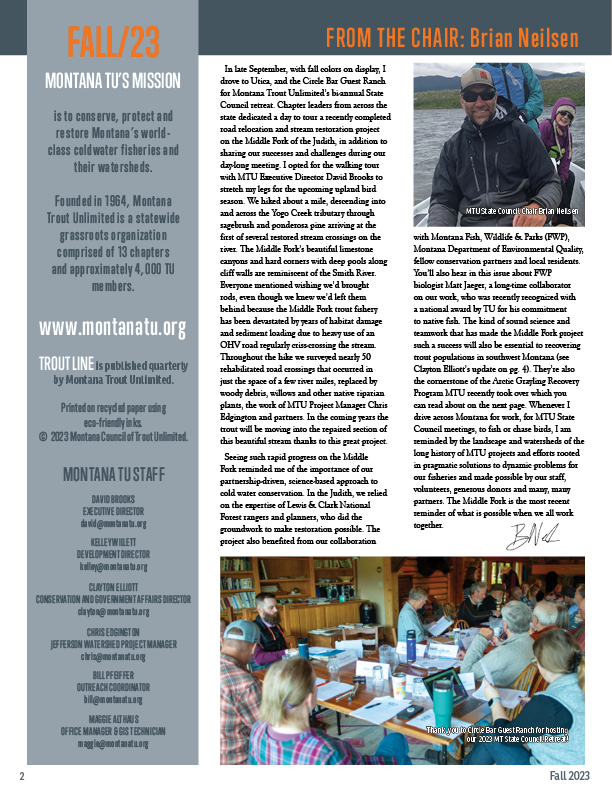
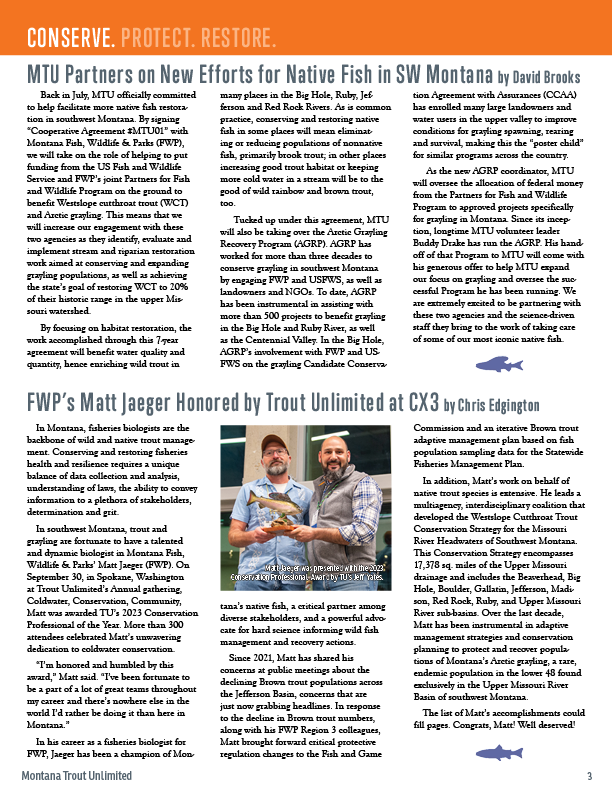
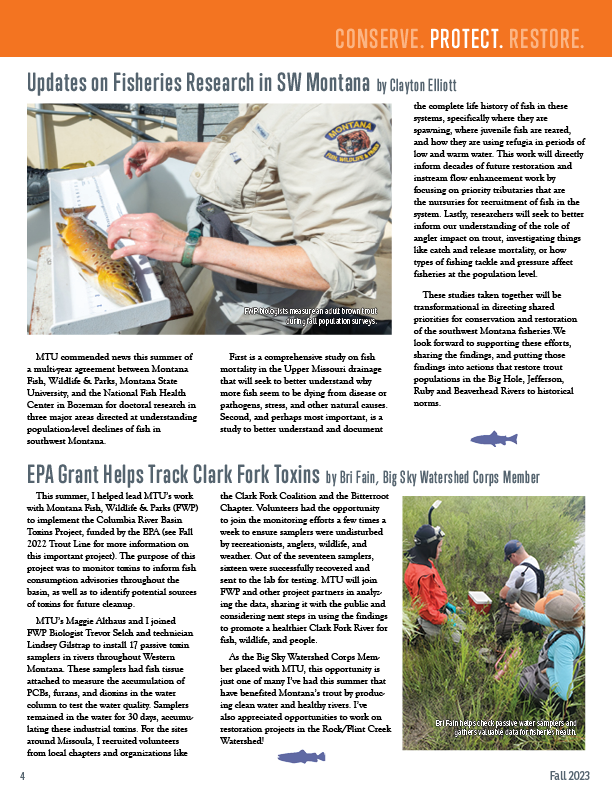
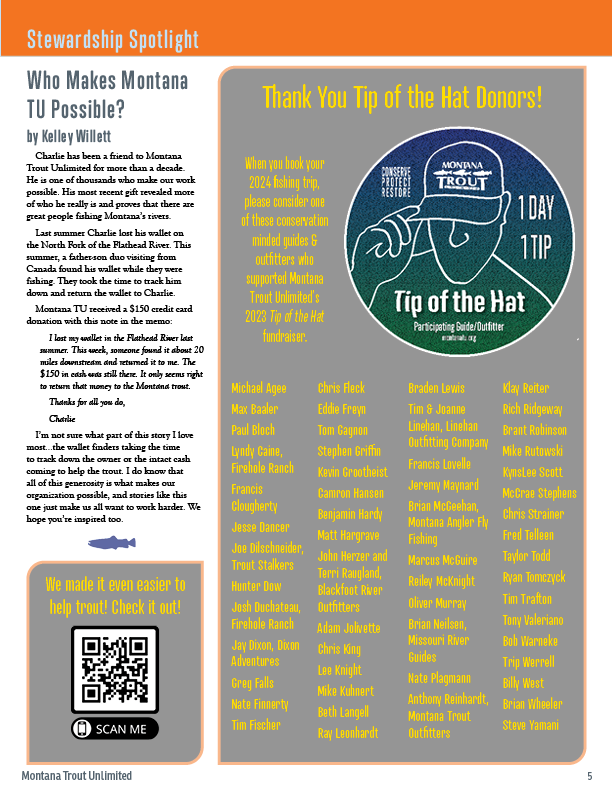
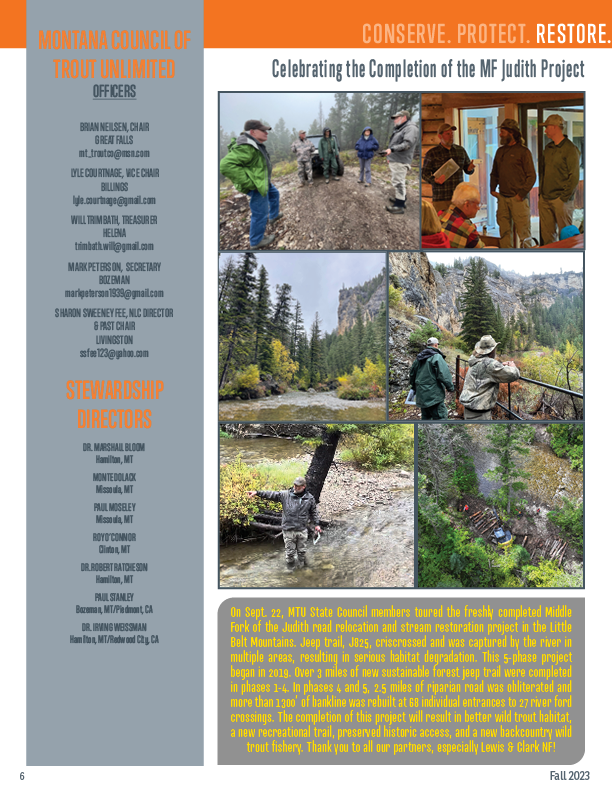
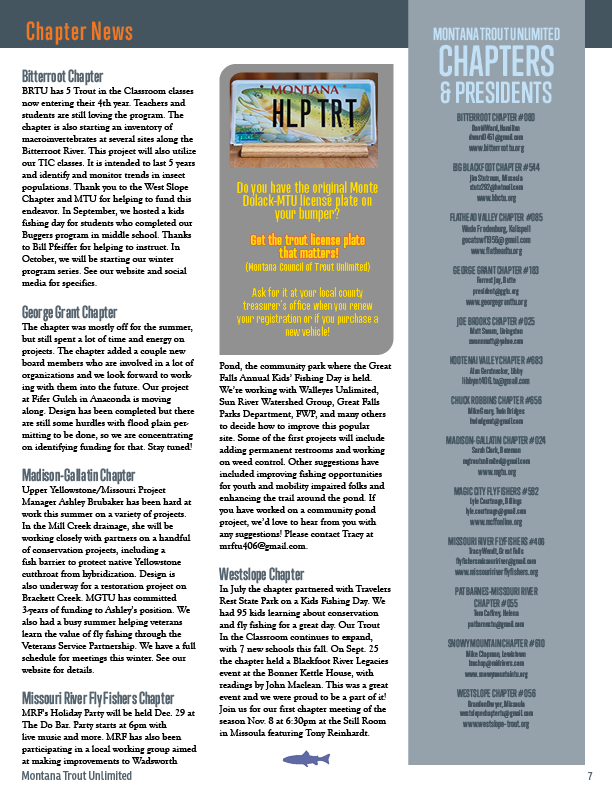
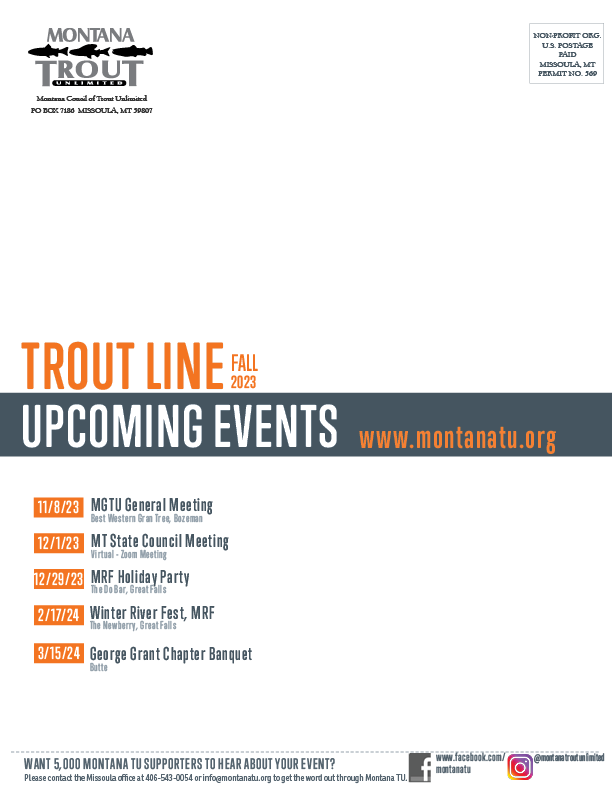
Trout in the Jefferson River may have more access to spawning areas and thermal refuge thanks to a new partnership announced today by Montana Trout Unlimited (MTU) that will remove three aging diversion dams on the Boulder River. MTU is collaborating with Barrick Gold, owners of the Golden Sunlight Mine, with complimentary support from Montana Fish, Wildlife & Parks (FWP), Natural Resource Conservation Service (NRCS), and L.R. Huckaba Ranch on the Boulder River near Cardwell, MT to increase stream flow and connectivity on the Boulder.
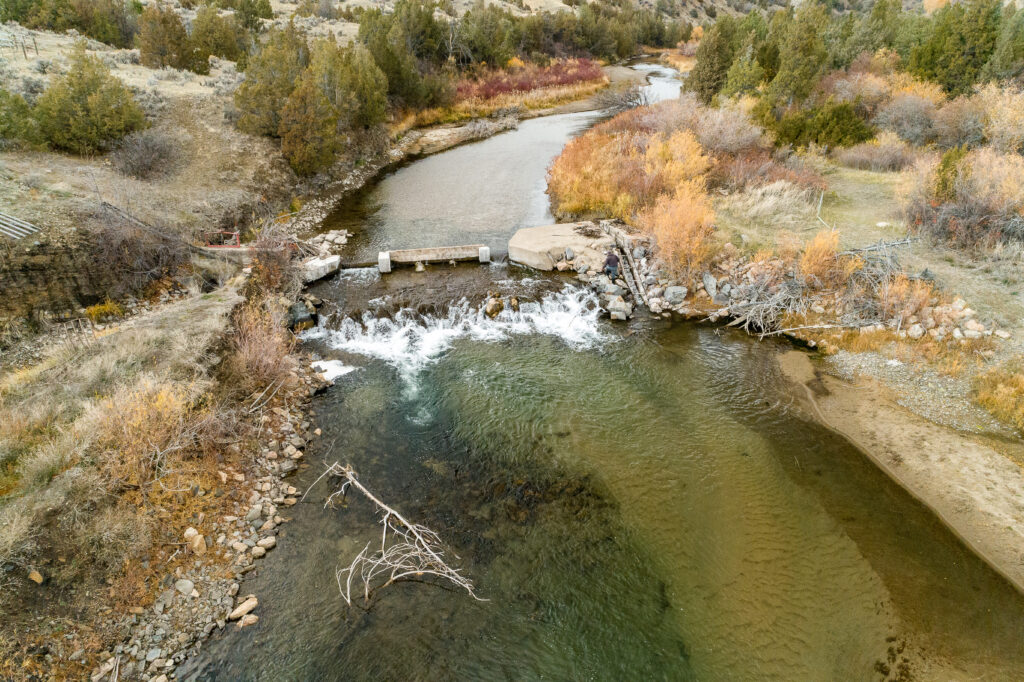
“We commend Barrick and Golden Sunlight for taking a proactive approach to replace deteriorating infrastructure and for considering the potential benefits for the river and all the creatures that rely on it,” said Chris Edgington, MTU’s Jefferson Watershed Project Manager. “With trout numbers near, or at historic lows across much of Southwest Montana, there’s no better time for a water quantity and quality project in this area. This is a great example of the win-win projects Montana Trout Unlimited strives to develop.”
Rising in the mountains north of Butte, the Boulder River is the largest tributary to the Jefferson River downstream of the Beaverhead-Big Hole River confluence, providing a boost of cold water near the midpoint of the Jefferson’s 83-mile length. The Boulder is a high-value coldwater fishery and provides significant agricultural production in Jefferson County. On the Candlestick Ranch, the Shaw Diversion Dam and two smaller diversions deliver water to 233 acres of cropland. The aging infrastructure is getting more difficult to operate and regulate irrigation withdrawal. This project will alleviate infrastructure concerns, by removing the diversion dams and replacing them with instream irrigation pumps, thereby providing a significant ecological uplift to the Boulder and Jefferson Rivers through stream restoration, water savings, continued agricultural benefit, and wetland development.
“We are excited to partner with Montana Trout Unlimited in the removal of a diversion from the Boulder River. This collaborative effort will help to ensure a healthy and thriving fishery for future generations. Barrick’s dedication to our community as well as the surrounding wildlife exemplifies our commitment to building sustainable legacies,” said Kristine Murphy, Golden Sunlight General Manager.
“This project is a win-win for trout and property owners, and we couldn’t be more excited to see it get off the ground,” said Edgington.
In April 2021, the partners met to discuss the challenges at the project site, to share what resources they could provide, and what the potential outcomes of the project could be. MTU, along with FWP and NRCS, developed a plan to collect baseline data to quantify project benefits. Methods of data collection have included stream and irrigation flow monitoring, continuous temperature monitoring, fish population estimates, redd counts, juvenile trout out-migration surveys, and a wetland delineation.
Quantifiable project benefits include:
“The project adds about 7 CFS of summer flow to the Jefferson River, and Boulder River water is 2 to 3 °F cooler than the Jefferson during August,” said Ron Spoon, FWP Fisheries Biologist.
Planning, engineering, and design for the dam removal and stream restoration will begin this fall. The partners anticipate project implementation in the fall/winter of 2025. For more information on this project, contact Chris Edgington at [email protected].
Our Summer 2023 Trout Line Newsletter is out now. Read it online here or download a PDF version for your favorite reading applications.
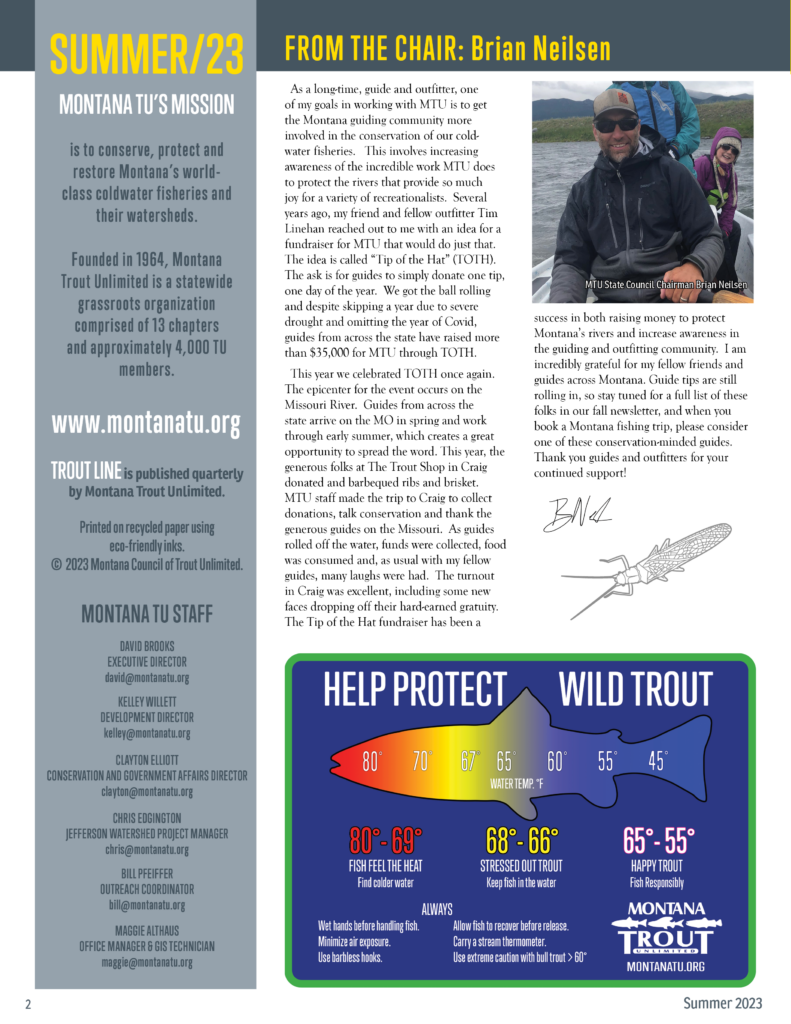
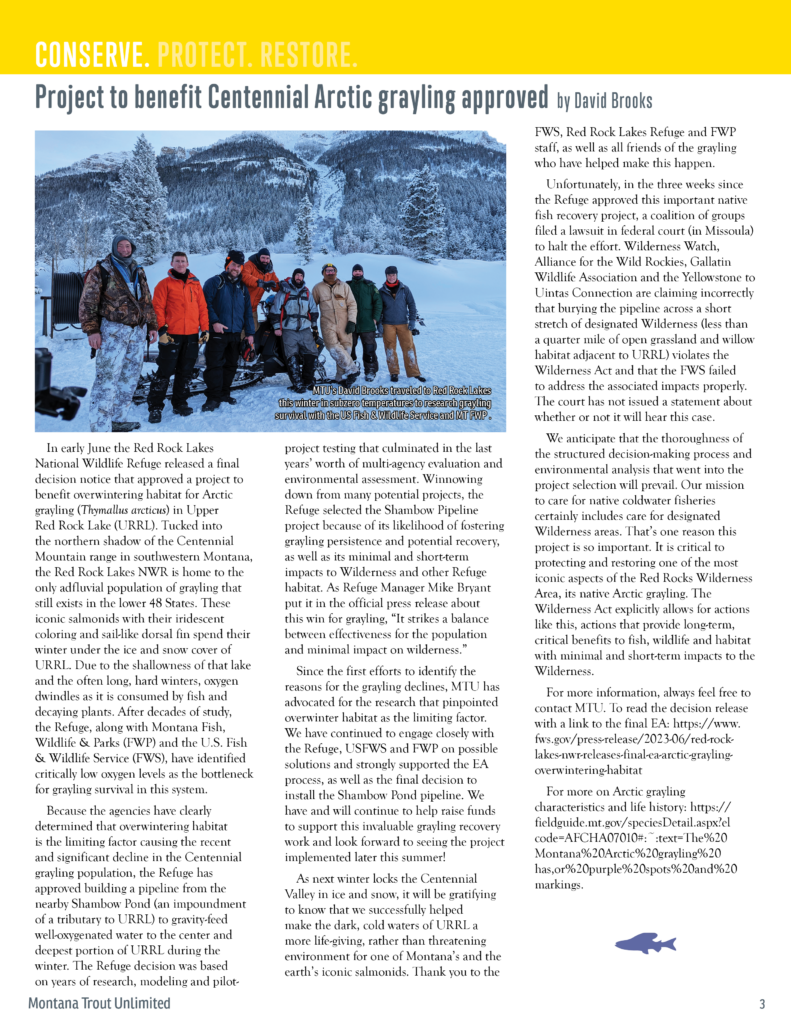
CENTENNIAL GRAYLING UPDATE: Unfortunately, after this issue went to print, federal District Judge Donald Molloy granted an injunction to stop the project until the case is fully heard, which likely means no project to benefit these grayling in 2023. This delay and its proponents stand to have far greater negative impacts to this Wilderness ecosystem by risking the disappearance of one of the most unique and iconic species than the short and modest construction efforts implementing the project in a Wilderness area would entail. This is a blow to the grayling, the spirit of collaborative conservation and Wilderness character. We remain optimistic that the Refuge decision and project will prevail on full hearing, assuming grayling survive another winter without our help. Stay tuned for more developments.
